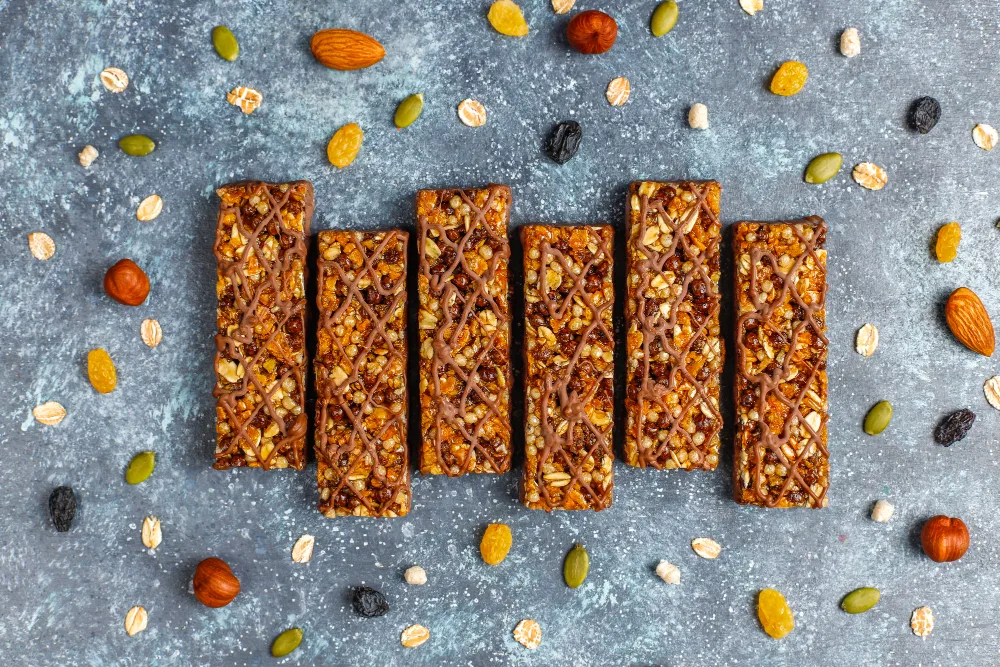Nutty, No-Bake and Nutritious
Homemade Energy Bars are a convenient, no-bake solution for busy lifestyles, athletes seeking quick refuels, or anyone desiring a wholesome alternative to store-bought snacks. Rather than relying on commercial products often laced with refined sugars, unnecessary additives, and minimal nutritional value, crafting your own bars empowers you to decide every ingredient and tailor flavors to your preferences. From choosing high-fiber oats and quality nuts to adding sweeteners sparingly, creating these bars ensures a balanced approach to sustained energy. This in-depth exploration covers why homemade energy bars benefit diverse dietary needs, how to select the right components, and the methods for transforming simple pantry staples into delicious, nutrient-packed bites—all without turning on the oven.
Why Homemade Energy Bars Are Worth Making
Advantages of DIY Snack Creations
Store-bought bars can be pricey or loaded with hidden sugars and preservatives. Embracing Homemade Energy Bars offers:
- Control Over Ingredients: Decide on sweeteners (like honey or dates), skip unhealthy fats, and add only the nuts or seeds you love.
- Reduced Costs: Buying ingredients in bulk (oats, nut butters, dried fruit) is often cheaper per bar than prepackaged options.
- Customization: Adjust textures (chewy, crunchy, or soft), flavor intensities, and macros to match personal dietary preferences.
- No-Bake Simplicity: Many recipes only require mixing ingredients, pressing them into a pan, and chilling—straightforward for novices.
According to Harvard T.H. Chan School of Public Health, more whole-food-based snacks in your diet can reduce cravings for highly processed items, supporting healthier eating patterns in the long run.
Who Benefits from Homemade Energy Bars
- Athletes and Active Individuals: Quick carbs, moderate protein, and essential fats replenish muscles and keep momentum high.
- Weight Managers: Pre-portioned bars encourage mindful snacking, preventing overindulgence.
- Office or School Goers: Portable, easily stored, and stable at room temperature, they help avoid vending machine temptations.
- Post-Bariatric Patients: Bars can be customized for higher protein, minimal sugar, and smaller portion sizes, fitting the needs of those on specialized diets.
For further healthy snack concepts, explore our post on Smart Snacking for Diabetes, which highlights low-sugar, balanced snacks also suitable for bariatric-friendly meal plans.
Key Ingredients for Homemade Energy Bars
Base Components for Binding
No-bake bars typically use sticky or cohesive elements to hold the mix together:
- Nut or Seed Butters: Peanut, almond, or sunflower seed butter add healthy fats and protein.
- Dates or Dried Fruits: Often pureed for natural sweetness and gooey consistency.
- Honey or Maple Syrup: Small amounts can help bind oats, nuts, or cereal clusters.
The ratio of these binding agents significantly influences bar texture, from dense and chewy to lightly crumbly.
High-Quality Protein Sources
Increasing protein content can turn your bars into a more sustaining snack:
- Whey or Plant-Based Protein Powder: An easy addition for those monitoring macros.
- Collagen Peptides: Promote joint and skin health while boosting protein.
- Seeds and Nuts: Almonds, walnuts, chia, or hemp seeds contribute moderate protein plus beneficial fats.
Maintaining the right balance ensures you don’t compromise palatability with a gritty feel from excessive powder.
Nutty and Grainy Fillers
Oats, nuts, and cereals provide the structural foundation for many Homemade Energy Bars:
- Rolled Oats: A staple for slow-release carbs and beta-glucan fiber, enhancing heart health.
- Whole-Grain Cereal: Adds crunch without resorting to sugar-laden puffed products.
- Shredded Coconut: Offers texture variety and subtle sweetness (choose unsweetened to limit added sugars).
Natural Sweeteners
While no sweetener is perfect, unrefined or lower-GI options are often used:
- Honey: Contains trace antioxidants, but portion control is key.
- Maple Syrup: A distinct flavor with fewer processed components than white sugar.
- Stevia or Monk Fruit: Zero-calorie sweeteners for individuals requiring low-sugar alternatives.
Whether you pick a minimal honey drizzle or a sugar-free approach, keep sweetness in check to align with dietary goals. The Bariatric Air Fryer Cookbook explores how to moderate sweeteners effectively in different snack contexts.
Crafting Your Own No-Bake Homemade Energy Bars
Step-by-Step Process
- Gather Ingredients
- Decide your base: oats, cereals, or a mix of seeds.
- Select a binder: nut butter, dried fruit puree, or honey.
- Include extras: protein powder, sweeteners, or flavor add-ins like cocoa nibs.
- Mix Dry Components
- Combine oats, chopped nuts, seeds, or cereals in a bowl.
- Stir in optional protein or collagen powder if desired.
- Prepare Binder
- In a separate bowl, blend nut butter, honey or maple syrup, and any pureed fruit.
- Warm gently in a microwave or stovetop to loosen consistency if thick.
- Combine Wet and Dry
- Pour the binder over your dry mix, folding thoroughly until everything is coated.
- The final texture should hold together when pressed, not be overly sticky.
- Press and Chill
- Line a baking dish with parchment paper.
- Press the mixture firmly to even out.
- Refrigerate for at least an hour or freeze briefly for faster setup.
- Slice and Store
- Cut into bars or squares, portioning them to your desired size.
- Keep in airtight containers; some bars can last up to a week in the fridge or a month in the freezer.
Variation Tips for Different Tastes
- Chocolate Chip Twist: Use dark chocolate chips (at least 70% cocoa) and reduce sweeteners elsewhere.
- Cranberry-Almond Fusion: Tart dried cranberries, almonds, and a pinch of orange zest.
- Tropical Flair: Include shredded coconut, dried pineapple chunks (sugar-free if possible), plus macadamia nuts or cashews.
For more advanced or specialized recipes, check our Bariatric Cookbook, featuring portion-controlled approaches to dessert-like bars and snacks.
Choosing the Right Consistency and Texture
Adjusting for Chewy Bars
If you prefer your homemade bars to be soft and chewy:
- Higher Binder Ratio: Add a bit more nut butter or date puree.
- Shorter Chill Time: Minimizing fridge time yields a softer final product.
- Less Cereal or Seeds: Lower crunchy add-ins to maintain pliability.
Creating Crunchier, Firmer Bars
Conversely, some enjoy crunchy bites:
- Crispy Rice Cereal: Provides airy crunch while still remaining fairly low in sugar.
- Increase Nuts/Seeds: More almonds, peanuts, or toasted seeds for a pronounced crisp.
- Longer Chill or Baking: While typically no-bake, brief toasting of the oats or cereals can up the crisp factor.
Avoiding Overly Sticky or Dry Outcomes
- Sticky Fix: If bars remain too tacky post-chilling, dust your hands with cocoa powder or a small amount of oat flour for easy handling.
- Dry Solutions: Add extra binder or a tablespoon of water if the mixture crumbles excessively before shaping.
Incorporating Homemade Energy Bars into Your Lifestyle
Bariatric Portion Management
After weight-loss surgery, portion sizes matter: a standard bar might still exceed your caloric or sugar limits. Tailor bar dimensions by:
- Scaling Down: Cut bars into smaller squares or rectangles, limiting each to ~100–150 calories.
- Balancing with Other Foods: Pair a mini-bar with a protein shake or half a piece of fruit for a more complete snack.
- Track and Adjust: Keep a food journal or use an app to ensure daily macros remain within your medical guidelines.
Ideal Times for Consumption
- Post-Workout Refuel: A moderate carb-protein ratio assists muscle recovery and energy.
- Midday Slump: Fight fatigue and avoid sugar-laden vending machine treats with a quick bar.
- Meal Replacements: If you’re on the go, carefully chosen bars can serve as partial meal stand-ins, but verify protein and calorie counts align with your plan.
Linking to Balanced Eating
In synergy with your meal plan, homemade bars fill the snack gap:
- Smart Snacking: Explore our Smart Snacking for Diabetes article for parallels in portion control and macro distribution.
- Meal Prep Rhythm: Prepare a week’s worth of bars alongside other staples like grilled chicken or boiled eggs for easy, healthy munching.
Common Mistakes and How to Avoid Them
Using Excess Sweeteners
Even natural sweeteners add calories and can spike blood sugar:
- Measure Precisely: Resist eyeballing honey or maple syrup.
- Limit Dried Fruits: Raisins or cranberries often contain added sugar; choose unsweetened or reduce other sweeteners if used.
- Flavor with Spices: Cinnamon, nutmeg, or cocoa powder can offset lower sugar levels by providing aromatic appeal.
Neglecting Protein or Essential Nutrients
Balancing macros ensures energy bars remain truly beneficial:
- Protein Powders: Add a scoop to your mixture.
- Nut Butter Over Butter: Use peanut, almond, or cashew butter to boost protein rather than saturated fat from dairy butter.
- Fortified Ingredients: Some cereals or plant-based milks offer extra vitamins or minerals.
Overfilling or Inconsistent Cutting
Uniformly sized bars make portion control simpler:
- Press Firmly: Pat the mixture flat, ensuring an even thickness.
- Use a Ruler or Pre-Scored Lines: Aim for consistent bar shapes to gauge nutritional data accurately.
Expert Advice and Supporting References
Consulting Nutritionists or Bariatric Specialists
Individuals with unique requirements should verify recipe components with licensed experts, especially post-surgery. Tailored input ensures your homemade bar’s macros match your medical plan. The Academy of Nutrition and Dietetics provides a directory of professionals who can help refine your approach.
Cookbooks for Additional Inspiration
Diving deeper into healthy snack-making:
- Bariatric Cookbook: Balances portion size, macros, and flavor for post-surgery success.
- Bariatric Air Fryer Cookbook: Crispy, low-fat snack techniques that complement homemade bars for variety.
Reference these works to expand your healthy snack repertoire beyond no-bake bars, from savory to sweet options.
Putting It All Together: A Healthier, Delicious Snack Routine
Summarizing the Advantages of Homemade Energy Bars
Homemade Energy Bars present numerous benefits:
- Customizable Flavors: Tweak sweetness or texture based on personal taste.
- Better Ingredient Quality: Substituting refined sugar with nutrient-rich honey or dates fosters more stable energy.
- Compatible with Bariatric Lifestyles: Smaller portion squares fit post-op capacity, maintaining macronutrient balance.
- Cost-Effective: Bulk buying oats, nuts, or seeds reduces snack costs in the long run.
- Convenience and Satiety: Quick to prep, ideal for busy days, sustaining you between meals or post-workout.
By adopting no-bake techniques, you skip complicated cooking procedures while reaping the rewards of a fresh, wholesome snack option.
Tips for Continual Snack Success
- Experiment Regularly: Adjust ingredient ratios to discover new favorite flavor combos.
- Track Your Macros: Keep an eye on protein, carbs, fat, and calorie counts if weight management is crucial.
- Store Smart: Keep bars in airtight containers or freeze them for future use, preventing spoilage or impulse bingeing on large batches.
- Rotate Snack Selections: Interchange bars with savory items, veggie sticks, or yogurt-based dips to prevent taste fatigue.
In combining creativity, portion mindfulness, and nutrient synergy, you solidify a sustainable strategy for tackling hunger without undermining your broader health goals.


Leave a Reply